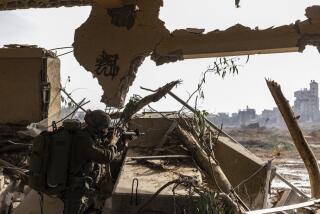Gang Violence Defies Navajo Tradition of Peace : Arizona: Tribal police suspect six murders in the Window Rock area last year were gang-related. Officers have seen the beginnings of turf wars, drive-by shootings, drug trafficking and retaliatory killings.
Beneath the red rock spires and ponderosa pines of the Navajo Nation, a scourge of urban America is leaving its mark in the spray-painted insignia of gangs.
Here on the nation’s largest Indian reservation, young men in baggy pants and bandannas strike a discordant note amid awe-inspiring canyons and cattle grazing quietly under clear skies.
More than 200 miles from the nearest big city, gangs are being blamed for an increase in beatings, stabbings, drug trafficking and killings.
“I beat up a couple of Dragons--stabbed a few,” said a 19-year-old Navajo who calls himself G Money.
The young man, dressed in black with a bandanna on his head, spoke unabashedly of his activities in the Insane Young Cobra Nation.
He said he’s never killed anyone but claims to have come close once--and he’s willing to try again.
“I’ll shoot any Dragon,” he said during a break from a family volleyball game recently, black eyes steely in his roly-poly face.
The Dragons are a rival group in Ft. Defiance, about seven miles north of the tribal capital of Window Rock in northeastern Arizona. Their spray-painted trademarks compete with those of the Cobras on concrete bridges, red cliff faces and the abandoned shell of a house within yards of G Money’s ramshackle home.
Navajo police said gang activity among the reservation’s 160,000 residents has escalated far beyond vandalism since the problem surfaced five years ago with a rash of beatings in middle-school bathrooms.
“It wasn’t really fights, it was just initiation rites in the bathrooms,” Capt. Francis Bradley said.
Next came colors, which identify members with their gangs, graffiti and beatings.
Police suspect six murders in the Window Rock area last year were gang-related and they have seen the beginnings of turf wars, drive-by shootings, drug trafficking and retaliatory killings.
A 14-year-old boy who committed suicide last year apparently did so because he was being pressured to join a gang, said Bill Smith, principal of Window Rock High School in Ft. Defiance.
The violence contradicts the traditions of the Navajo, who long ago were warriors before turning to the peaceful pursuits of sheepherding, silversmithing and weaving learned from their Pueblo neighbors.
The gang culture threatens to overshadow the family loyalty prized by traditional Navajo, Smith said.
“More and more families are being affected by the fighting,” Smith said. “It’s really amazing when you talk to a kid and they say, ‘Yeah, it’s my cousin and I beat up on him and I feel bad about it,’ but they do.”
Young people on the reservation, like those elsewhere, often join gangs out of a need for group identity. Navajo officials view the trend as tragedy in a tribe with a proud cultural identity of its own.
“They’re searching for where they belong,” said tribal President Albert Hale Jr. “They don’t realize they also belong to the Navajo Nation.”
The pressure to straddle two worlds--the Navajo and the American pop culture imported through TV and tourism--leaves teen-agers vulnerable.
“The kids just don’t have anything to believe in, and I sense that’s the heart of it,” Smith said. “The traditional belief system gives them something to work with, and I think they need that.”
G Money, who understands the Navajo language used in his home but can’t speak it, said his tribe and gang affiliations are completely separate. He said being a gangster is about getting the respect missing in his life.
Young people from the Window Rock area--population 3,300--also are spreading their inner-city mentality to smaller, rural communities scattered across the reservation’s 24,000 square miles in Arizona, New Mexico and Utah.
Tribal police have just two officers assigned full time to gang cases, both of them in Window Rock.
“We need a unit in every police district to deal with the problem,” said Sgt. Frank Bradley, one of the two officers. There are seven districts.
Officials at the 800-student high school have banned the green-and-black hooded sweat shirts and bandannas favored by the Cobras. They have confiscated weapons including motorcycle chains, spiked collars, retractable razor blades, knives sheathed in notebook paper--and guns.
The problems may dwindle during class hours, but it is growing outside school walls.
“It’s when you come out here to the streets, that’s when you’ve got to watch your back,” G Money said. “It’s getting worse out here.”
More to Read
Start your day right
Sign up for Essential California for news, features and recommendations from the L.A. Times and beyond in your inbox six days a week.
You may occasionally receive promotional content from the Los Angeles Times.






